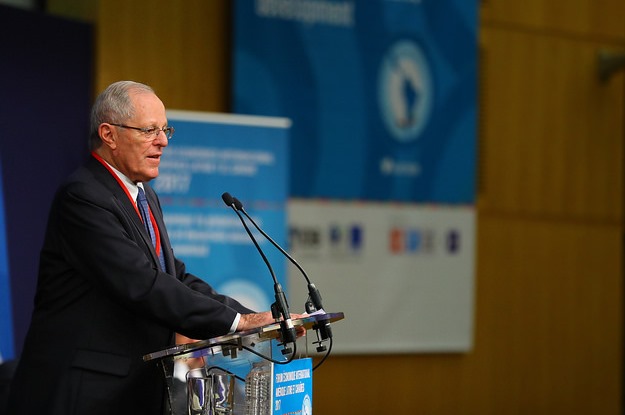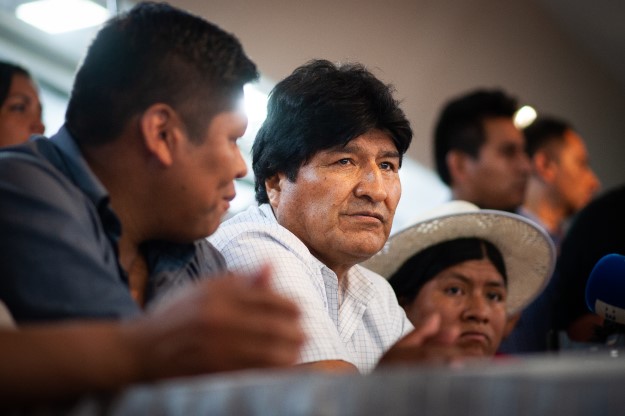This article has been updated. Correction appended below.
Twelve months ago, Pedro Pablo Kuczynski pulled off a major upset when he beat Keiko Fujimori, daughter of the jailed hard-right strongman Alberto Fujimori, in Peru’s presidential runoff.
The septuagenarian centrist economist squeaked in by just 41,000 votes — out of a total of more than 17 million — after Fujimori’s populist campaign was undermined by serious corruption allegations, including the revelation that her principal financier was being investigated by the U.S. Drug Enforcement Administration.
Many in Peru regarded the result as a victory for decency and the rule of law. Kuczynski’s triumph marked the climax of a distinguished career with stints as economy minister, prime minister, a senior World Bank official and a successful investment banker. Fujimori, meanwhile, had failed to distance herself from the troubled legacy of her father, whose 1990-2000 presidency is remembered as a kleptocracy that bought off journalists and rigged elections while overseeing a string of grave human rights abuses.
One year on, however, and Kuczynski’s administraton is increasingly besieged, to the point where many Peruvians worry about the implications for their fragile democracy and for the fight against the endemic corruption that has hamstrung economic development.
At the root of the problem is the congressional majority won by Fujimori’s People’s Force party and their willingness to use post-truth rhetoric and hardball tactics to undermine the government. That includes impeachment proceedings against well-regarded ministers from Kuczynski’s cabinet on the basis of flimsy – or simply false – allegations of misconduct.
Thanks to Peru’s open-list electoral system, People’s Force won 73 of 130 seats in Peru’s single-chamber Congress despite only picking up 36 percent of the votes. That compares with just 18 seats for Kuczynski’s Peruvians for Change party.
Meanwhile, the leftist Broad Front alliance, which won 20 seats and might have been expected to support the president’s attempts to tackle graft and overhaul the police and judiciary, even while strongly opposing his free market economic agenda, has turned out to be hopelessly divided.
That has left Kuczynski badly exposed. Exercising tight control over her disciplined congressional bloc, Fujimori, 41, who has barely spoken in public since her surprise election loss, has been widely characterized as a sore loser motivated by revenge.
Eduardo Dargent, a political science professor at the Pontifical Catholic University of Peru, is among those who wonder whether People’s Force has a strategy or is simply being propelled by pique.
“It’s hard to tell if there is a plan or if it is just members of the hard wing of Fujimorismo competing among themselves to come up with the most outspoken attack on the government,” said Dargent.
Intentional or not, their actions could have grave consequences, he warned.
“An attempt to vacate the president is a possibility,” Dargent added. “It is important to think about it, although that does not mean that the Fujimoristas have it as an objective and are working towards it. It could be more opportunistic, depending on the right issue becoming sufficiently politicized.”
Kuzcynski’s troubles began in December with the impeachment of the highly regarded education minister Jaime Saavedra, who had been kept on from the administration of former President Ollanta Humala.
The charges against him related to a suspect purchase of computers and delays in preparations for the 2019 Pan-American Games, which will be hosted in Lima and fall under the education brief. Yet few outside People’s Force buy that explanation and most believe the real motivation was Saavedra’s overhauling of Peru’s disastrous education system, which jeopardized the profit margins of various highly lucrative but academically suspect private universities, many linked to Fujimoristas.
The tone of the impeachment debate was epitomized by Fujimorista congressman Luis Galarreta effectively accusing the OECD of “psychological warfare” for its recent release of the PISA rankings, which showed Peru improving its previous rock-bottom ratings in literacy and numeracy under Saavedra’s leadership.
After his ouster, Saavedra was promptly snapped up by the World Bank, which named him the institution’s top education official. Yet in Peru the impeachments are set to continue.
Transport minister Martin Vizcarra was forced to resign in June to avoid a similar fate as Saavedra. The Fujimoristas are now calling for the heads of interior minister Carlos Basombrio and economy minister Alfredo Thorne, both on charges most independent observers regard as equally trumped up as those that brought down their former colleagues, and appear to be setting the table for impeachment debates for both officials.
Meanwhile, Kuczynski’s handling of the Fujimorista intransigence has been less than sure-footed. He has repeatedly made conciliatory sounds regarding the Fujimoristas and ignored supporters’ calls to stage a congressional vote of confidence in his cabinet. Should his cabinet lose two such votes, that would automatically trigger new legislative elections — in which the Fujimoristas might fail to win another majority.
At one point, the president was even seen meeting and praying with Keiko Fujimori at the residence of Lima’s highly conservative Archbishop Juan Luis Cipriani, a gesture interpreted by some as undermining his own authority.
“It is clearly the parliament that is setting the national agenda,” says Julio Arbizu, a former chief anti-corruption prosecutor. “Unfortunately, Kuczynski is a weak president who has distanced himself from the strategic anti-Fujimorista alliance, which included many on the left, which helped him win the presidency.”
The confrontation comes at a difficult time for Peru, which has been rocked by the Odebrecht mega-scandal perhaps more than any other nation outside Brazil.
All three former presidents spanning 2001-2016 have come under suspicion. Alejandro Toledo, accused of taking $20 million in kickbacks, is fighting extradition from California. Meanwhile, the parade of other graft scandals involving the judiciary, regional and municipal governments, and many other public institutions seems to never end.
Dangerously, these attacks come at a time when many Peruvians are already thirsting for a strong hand. With poverty and inequality still widespread, and public institutions badly in need of reform, nearly 40 percent of Peruvians say they would accept an authoritarian government if it were effective at resolving problems.
Congress also faces deep public mistrust. That is thanks, in part, to the Fujimoristas, whose lawmakers have been accused of a roster of misdeeds, from faking educational qualifications to possible links with the cocaine trade and failing to pay child support.
Indeed, along with the judiciary, political parties and the Congress are perceived as two of the three most rotten institutions in the country. Having a legislative majority, and using it in a high-handed way, could yet have a significant downside for People’s Force.
What is clear is that this squabbling is only intensifying Peruvians’ dismal estimation of the entire political class. But until the next presidential elections, scheduled for 2021, Peru will likely continue to experience political uncertainty, with an isolated executive hounded by an unpopular legislature. It is a state of affairs in which everyone loses — voters most of all.
This article was updated to describe opposition tactics against the Kuczynski government in more detail.
This article has been corrected to properly cite the full organizational name of the Drug Enforcement Administration (DEA).
—
Tegel is a journalist based in Lima, Peru








